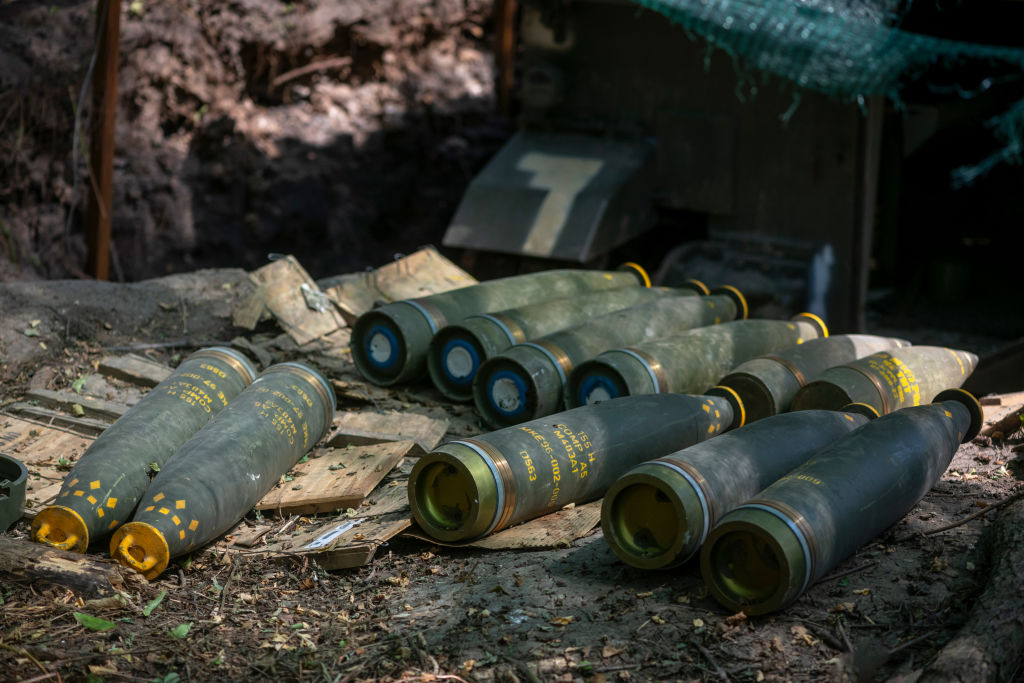JACK WATLING

Since Russia’s full-scale invasion of Ukraine in February 2022, one type of weapon has loomed large over every other. Artillery has accounted for about 80% of casualties on both sides. Yet political deadlock in the U.S. Congress over military assistance to Ukraine, combined with a lack of production capacity in Europe, is leading to a critical shortage in artillery ammunition that could spell disaster for Ukraine’s war effort.
The shortage of ammunition is already being felt across the front, and contributed to Ukraine's recent withdrawal from the town of Avdiivka.
Artillery is both versatile and devastating. A Ukrainian battery of M109 howitzers, for example, can theoretically land around 530 lbs. of high explosive anywhere within 15 miles with a latency of about 3-5 minutes. Depending on the fuzing, these rounds can fill the air with shrapnel, or bury into the ground and collapse fortifications. The effect is not just the physical damage inflicted, but the psychological fear artillery instills in soldiers and the constraints it imposes on an opposing force that must plan to deal with this threat.
Ukraine today is facing around 470,000 Russian troops who every day attack Ukrainian positions using assault groups of infantry. If Ukraine had sufficient artillery, these attacks can be easily repelled because a few rounds of 155 mm caliber fire would kill the attackers as soon as they began to advance from their covered positions. But Ukraine is having to ration its units to fire only 2,000 rounds a day across a 750 mi. front. Ukraine fields around 350 artillery pieces, so that in many areas of the front Ukraine has no artillery at all.
The shortage of guns and shells not only reduces Ukraine’s ability to blunt Russian attacks, but also makes Ukrainian artillery more vulnerable to Russian Lancet-3M drones and counter battery fire. Russia has more than 4,000 artillery pieces in Ukraine, and is firing around 10,000 rounds a day across the front. So when a Ukrainian howitzer opens fire, it must either keep out of range of the Russian guns, limiting how much of the line it can protect, or move quickly to avoid being destroyed by the Russians firing back.
Moving the guns also reduces the number of rounds that can be fired for a given mission. By contrast, the Russians can move one gun and start firing with another. This constant artillery threat makes it extremely dangerous for Ukrainian units to go on the attack, giving Russian forces more freedom to plan and concentrate units in preparation for assaults.
Ukrainian forces are trying to make up for their critical deficiency in equipment through the use of novel tactics and First Person View drones. The advantage of FPVs is that they are highly accurate and can be manoeuvred to hit moving targets. They can also be flown from relative safety. In this way, the Ukrainians have inflicted a significant number of vehicle losses on Russian forces.
But FPVs are not a substitute for artillery. If the enemy has set up a strong electronic warfare baseline, then the FPVs cannot fly. If the weather is bad, they will struggle to find their targets. Because they rely on batteries, their range is significantly reduced in cold weather. Fundamentally, they are unreliable and lack a large enough charge to deliver many of the effects that artillery can. FPVs are most effective when used in combination with artillery, with the latter destroying or suppressing electronic warfare systems, allowing the FPVs to precisely target enemy vehicles.
Without sufficient ammunition, the Ukrainian military will have to physically occupy more positions along the front to defeat Russian attacks with small arms. This will both increase Ukrainian casualties and reduce the number of personnel who can be kept away from the frontline to train and prepare for future offensive operations. In short, without artillery ammunition, the Ukrainians risk being fixed in permanent defense, slowly ceding ground as most recently seen in Avdiika.
If the U.S. approves funding for Ukraine—the Senate passed $60 billion in aid last week but it faces steep hurdles in the House—it should be possible to get around 1.3 million rounds of ammunition to the country in 2024, which would allow Ukraine to hold the line. With European investment to expand production, significantly more can be provided in 2025, meeting a level that would enable Ukrainian offensive operations. But with Europe still expanding production capacity, Ukraine will face critical shortages in the next few months unless the U.S. steps in.
Russia understands the importance of artillery in a war of attrition. While Russian artillery use has been crude and has underperformed, the sheer volume of shells it is expending has given Moscow a decisive battlefield edge today. The country is set to produce another 1.3 million rounds of 152 mm caliber ammunition in 2024, along with around 800,000 rounds of 122 mm caliber ammunition. Alongside a remaining stockpile of around 3 million rounds, the delivery of over 1 million rounds from North Korea, and production contracts signed with North Korea, Belarus, Iran, and Syria, Russia will continue to have firepower dominance throughout the year.
In spite of these advantages, Russia’s firepower dominance will potentially diminish over time. Although its shell production can increase, Russia has so far relied heavily on taking barrels from old Soviet systems it held in storage. By 2025, these stocks will be running low and Russia’s capacity to forge barrels is insufficient to meet its future needs.
The result is that through 2025 the accuracy of Russian guns, and the number that are available at any given time, may diminish. That may give Ukraine and its backers some hope in the longer run. But the critical question is whether the U.S. is willing to sustain the fight for the next year, before the tide begins to turn once again in Ukraine’s favor.
No comments:
Post a Comment